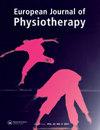Effects of progressive neuromuscular training on pain, function, and balance in patients with knee osteoarthritis: a randomised controlled trial
IF 1.1
Q3 REHABILITATION
引用次数: 1
Abstract
Abstract Background Sensorimotor dysfunction is one of the factors leading to advancement of knee osteoarthritis (OA). Limited evidence supports the use of neuromuscular training (NMT) incorporating all the elements of sensorimotor function viz. strength, balance, coordination, and proprioception, hence the current study aimed to evaluate the efficacy of NMT integrating all aspects of sensorimotor function on pain, function, and balance in patients with knee OA. Material and methods This single-blinded RCT recruited 62 subjects (40–65 years) with KL grade II-III of knee OA, who were randomly allocated into two groups namely NMT or strengthening group (twice a week for 6 weeks). Outcomes were assessed for pain (NPRS), function (CRD version of WOMAC, PSFS, chair stand test, stair climb test, timed up and go test), and balance (Y-balance) at baseline and at the completion of the intervention. Results 54 subjects completed the trial. Although both groups had significant improvement NMT was more effective (p value < 0.05) for most clinical outcomes of NPRS, Y-balance, and WOMAC with low-moderate effect size and objective functional tests – chair stand test and timed up and go test. Conclusion NMT was more effective in improving the clinical outcomes of pain, function (except PSFS), and balance in subjects with KL grade II-III knee OA. Knee OA patients may benefit with addition of NMT to their intervention. However, due to limitations of low effect size, the results should be considered with caution.渐进式神经肌肉训练对膝关节骨关节炎患者疼痛、功能和平衡的影响:一项随机对照试验
摘要背景感觉运动功能障碍是导致膝骨关节炎(OA)进展的因素之一。有限的证据支持使用神经肌肉训练(NMT),它结合了感觉运动功能的所有元素,即力量、平衡、协调和本体感觉,因此目前的研究旨在评估NMT结合感觉运动功能所有方面对膝关节骨性关节炎患者疼痛、功能和平衡的疗效。材料和方法这项单盲随机对照试验招募了62名受试者(40-65 年),KLⅡ-Ⅲ级膝关节骨性关节炎患者,随机分为两组,即NMT组或强化组(每周两次,共6次 周)。在基线和干预完成时,评估疼痛(NPRS)、功能(CRD版WOMAC、PSFS、椅子站立测试、爬楼梯测试、定时出发测试)和平衡(Y-balance)的结果。结果54名受试者完成了试验。尽管两组都有显著改善,但NMT对NPRS、Y-balance和WOMAC的大多数临床结果更有效(p值<0.05),具有中低疗效大小和客观功能测试——椅子站立测试和定时出发测试。结论NMT在改善KLⅡ-Ⅲ级膝关节骨性关节炎患者的疼痛、功能(PSFS除外)和平衡方面更有效。膝关节骨性关节炎患者可能受益于NMT的干预。然而,由于低效应大小的限制,应谨慎考虑结果。
本文章由计算机程序翻译,如有差异,请以英文原文为准。
求助全文
约1分钟内获得全文
求助全文

 求助内容:
求助内容: 应助结果提醒方式:
应助结果提醒方式:


